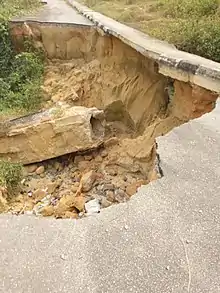Nigeria gully erosion crisis
The Nigeria gully erosion crisis has been ongoing since before 1980, and affects communities large and small. It is an ecological, environmental, economic, and humanitarian disaster resulting in land degradation, loss of lives, and properties worth millions of dollars. The estimated number of gullies in the country is at 3,000. Gullies and areas exposed to erosion in Southeastern Nigeria tripled from about 1.33% (1,021 km2) in 1976 to about 3.7% (2,820 km2) in 2006 making the region the most affected region in the country.[1]

Causes
Gullies are majorly caused by surface runoff, the erosion occurs, notably, in gullies, which grow wider and deeper with each rainfall. Many of the gullies have become ravines, which can be dozens or hundreds of feet deep. Some natural processes can induce gullies, such as high amounts of rainfall, poor soil infiltration and unfavorable catchment shape.[2]
However, in Nigeria, the causes of gully formation can be largely attributed to human activities such as:
- Poor road design, construction and abrupt termination of drains: When drains are not properly terminated, the flow in them usually with high pressure will disperse the earth below causing gullies rather than flow to lower catchment areas.
 Poorly terminated drain, a major cause of gully erosion
Poorly terminated drain, a major cause of gully erosion - Poor waste management practices: Poor waste management practices such as dumping of refuse into drains and waterways prevent the proper flow of water. This practice results in flooding and if unchecked, it can lead to erosion of the top layer of the soil.
- Unsustainable land use practices: Practices such as improper sand mining strips away the top soil and tilling process associated with crop cultivation loosens the top soil, creating paths for runoff. [1]
Though concentrated in several towns and states in the Southeastern part of the country, the crisis affects all Nigerians indirectly. Homes and structures routinely collapse, as the gullies expand with each rainy season.[3] Unchecked, the phenomenon will eventually transform the region into a badland.
Impact
Impacts caused by this environmental menace includes:
- loss of infrastructure including roads, houses, and other real estate.
- loss of agricultural land and vegetation.
- Increased siltation in rivers leading to flooding.
- Increased sedimentation in waterways.
Major interventions
In 2010, President Goodluck Ebele Jonathan made a request to the World Bank Nigeria office for assistance in addressing the challenges of gully erosion, emerging Land degradation and environmental insecurity in the country. This request resulted in the formation of the Nigeria Erosion and Watershed Management Project (NEWMAP), an eight (8) year multi-sectoral project aimed at addressing gully erosion in the Southern Nigeria and land degradation in the Northern Nigeria.[4] The development objective of the NEWMAP is to reduce vulnerability to soil erosion in targeted sub-watersheds with a portfolio of US $508 million plus an additional financing of $400 million. The Team Leaders of this project are Amos Abu, Ruth Jane Kennedy-Walker and Grant Milne.
Before this intervention, several interventions failed to address the challenge of gully erosion mainly because of inefficiencies in designing proper structures and lack of commitment by the locals to take action.[1]
However, in some areas like Madona gully site, Awhum community Enugu State, and Okudu community Imo State, some sustainable interventions base on good practices were employed. These interventions addressed the menace of gully erosion in those areas.[1]
References
- Bank, The World (2012-04-12). "Nigeria - Erosion and Watershed Management Project". Cite journal requires
|journal=(help) - author. "Gully erosion". NSW Environment & Heritage. Retrieved 2018-02-05.
- http://www.voanews.com/content/erosion-threatens-nigeria-villages/1680362.html
- "About Us – NEWMAP". newmap.gov.ng. Retrieved 2018-02-05.